PPMP20011 - Projects Negotiation and Conflict Report: QLD Health
VerifiedAdded on 2023/06/15
|8
|2195
|137
Report
AI Summary
This report analyzes the negotiation and conflict dynamics within the Queensland Health Payroll project (PPMP20011). It examines four key projects: forward strategy for the payroll system, governance and decision-making, people and change management, and funding. For each project, the report identifies the owners, designers, and contractors, exploring their negotiating positions and potential conflicts. It recommends negotiation strategies such as structural, strategic, behavioral, and concessional exchange approaches, along with cooperative and competitive negotiation methods. The report concludes by outlining the preferred outcomes for each project, emphasizing innovation, organized management, positive staff relations, and budget adherence. This detailed analysis offers insights into managing negotiations and mitigating conflicts in large-scale projects. Desklib provides access to a wealth of similar solved assignments and past papers for students.
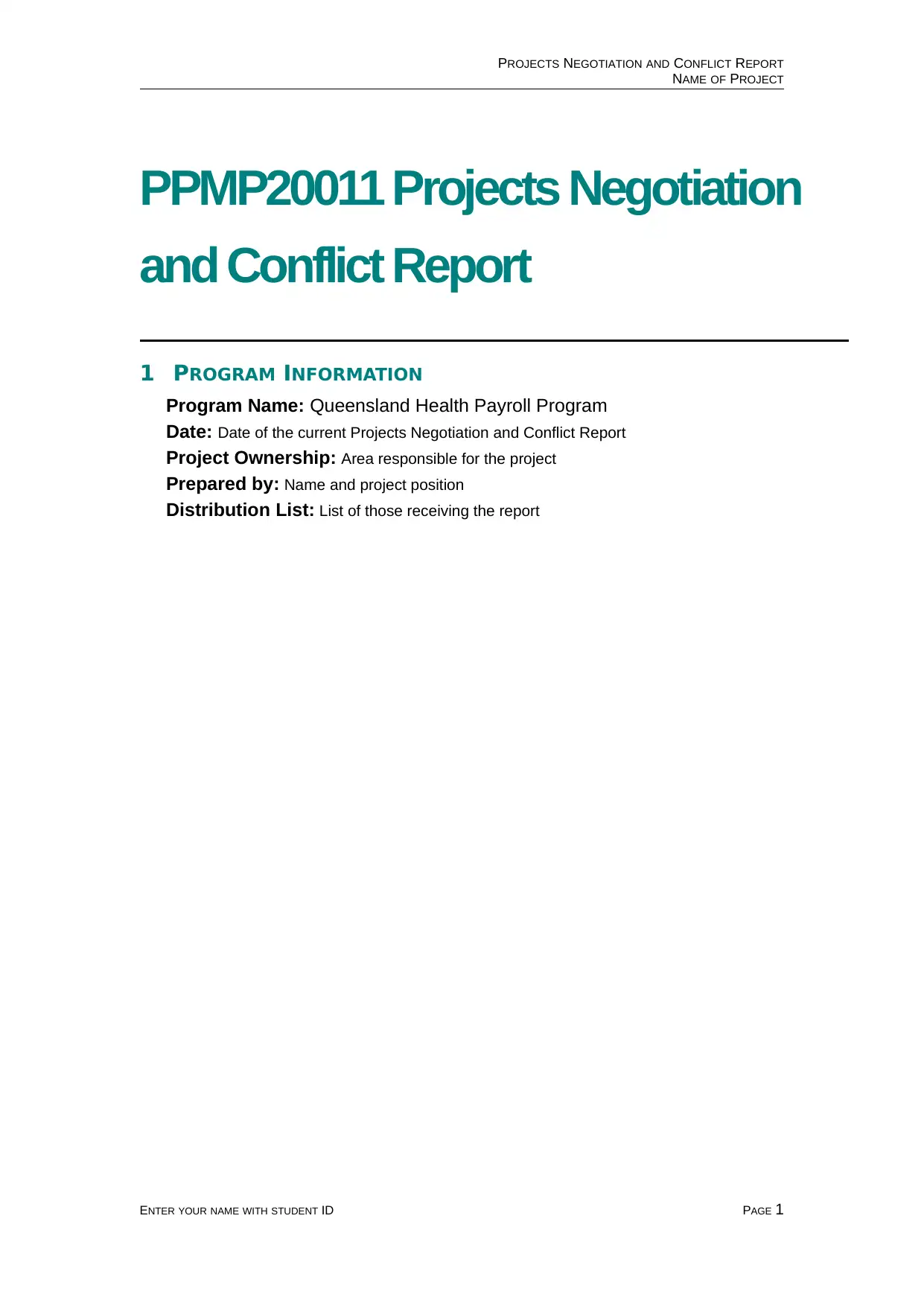
PROJECTS NEGOTIATION AND CONFLICT REPORT
NAME OF PROJECT
PPMP20011 Projects Negotiation
and Conflict Report
1 PROGRAM INFORMATION
Program Name: Queensland Health Payroll Program
Date: Date of the current Projects Negotiation and Conflict Report
Project Ownership: Area responsible for the project
Prepared by: Name and project position
Distribution List: List of those receiving the report
ENTER YOUR NAME WITH STUDENT ID PAGE 1
NAME OF PROJECT
PPMP20011 Projects Negotiation
and Conflict Report
1 PROGRAM INFORMATION
Program Name: Queensland Health Payroll Program
Date: Date of the current Projects Negotiation and Conflict Report
Project Ownership: Area responsible for the project
Prepared by: Name and project position
Distribution List: List of those receiving the report
ENTER YOUR NAME WITH STUDENT ID PAGE 1
Paraphrase This Document
Need a fresh take? Get an instant paraphrase of this document with our AI Paraphraser
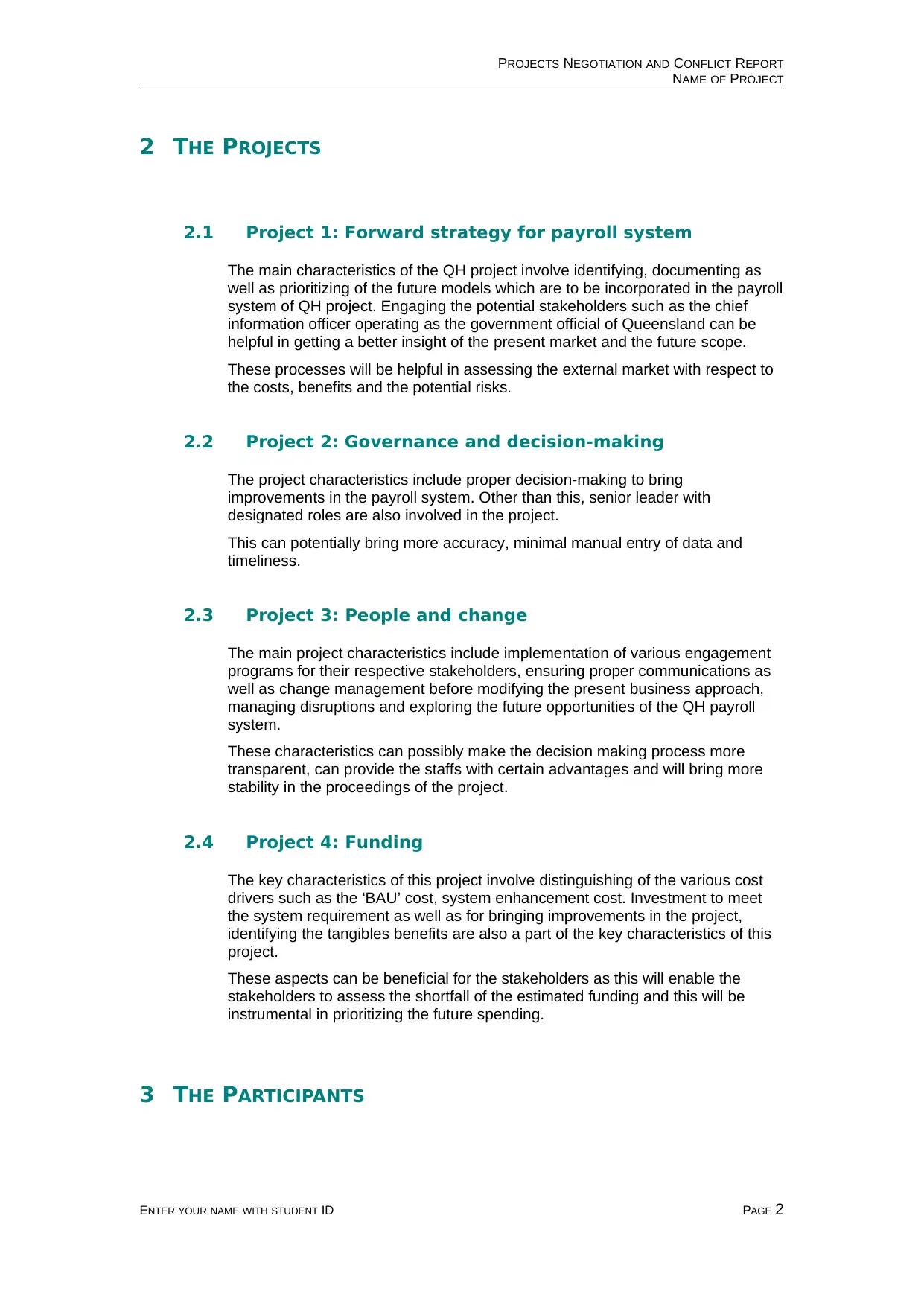
PROJECTS NEGOTIATION AND CONFLICT REPORT
NAME OF PROJECT
2 THE PROJECTS
2.1 Project 1: Forward strategy for payroll system
The main characteristics of the QH project involve identifying, documenting as
well as prioritizing of the future models which are to be incorporated in the payroll
system of QH project. Engaging the potential stakeholders such as the chief
information officer operating as the government official of Queensland can be
helpful in getting a better insight of the present market and the future scope.
These processes will be helpful in assessing the external market with respect to
the costs, benefits and the potential risks.
2.2 Project 2: Governance and decision-making
The project characteristics include proper decision-making to bring
improvements in the payroll system. Other than this, senior leader with
designated roles are also involved in the project.
This can potentially bring more accuracy, minimal manual entry of data and
timeliness.
2.3 Project 3: People and change
The main project characteristics include implementation of various engagement
programs for their respective stakeholders, ensuring proper communications as
well as change management before modifying the present business approach,
managing disruptions and exploring the future opportunities of the QH payroll
system.
These characteristics can possibly make the decision making process more
transparent, can provide the staffs with certain advantages and will bring more
stability in the proceedings of the project.
2.4 Project 4: Funding
The key characteristics of this project involve distinguishing of the various cost
drivers such as the ‘BAU’ cost, system enhancement cost. Investment to meet
the system requirement as well as for bringing improvements in the project,
identifying the tangibles benefits are also a part of the key characteristics of this
project.
These aspects can be beneficial for the stakeholders as this will enable the
stakeholders to assess the shortfall of the estimated funding and this will be
instrumental in prioritizing the future spending.
3 THE PARTICIPANTS
ENTER YOUR NAME WITH STUDENT ID PAGE 2
NAME OF PROJECT
2 THE PROJECTS
2.1 Project 1: Forward strategy for payroll system
The main characteristics of the QH project involve identifying, documenting as
well as prioritizing of the future models which are to be incorporated in the payroll
system of QH project. Engaging the potential stakeholders such as the chief
information officer operating as the government official of Queensland can be
helpful in getting a better insight of the present market and the future scope.
These processes will be helpful in assessing the external market with respect to
the costs, benefits and the potential risks.
2.2 Project 2: Governance and decision-making
The project characteristics include proper decision-making to bring
improvements in the payroll system. Other than this, senior leader with
designated roles are also involved in the project.
This can potentially bring more accuracy, minimal manual entry of data and
timeliness.
2.3 Project 3: People and change
The main project characteristics include implementation of various engagement
programs for their respective stakeholders, ensuring proper communications as
well as change management before modifying the present business approach,
managing disruptions and exploring the future opportunities of the QH payroll
system.
These characteristics can possibly make the decision making process more
transparent, can provide the staffs with certain advantages and will bring more
stability in the proceedings of the project.
2.4 Project 4: Funding
The key characteristics of this project involve distinguishing of the various cost
drivers such as the ‘BAU’ cost, system enhancement cost. Investment to meet
the system requirement as well as for bringing improvements in the project,
identifying the tangibles benefits are also a part of the key characteristics of this
project.
These aspects can be beneficial for the stakeholders as this will enable the
stakeholders to assess the shortfall of the estimated funding and this will be
instrumental in prioritizing the future spending.
3 THE PARTICIPANTS
ENTER YOUR NAME WITH STUDENT ID PAGE 2
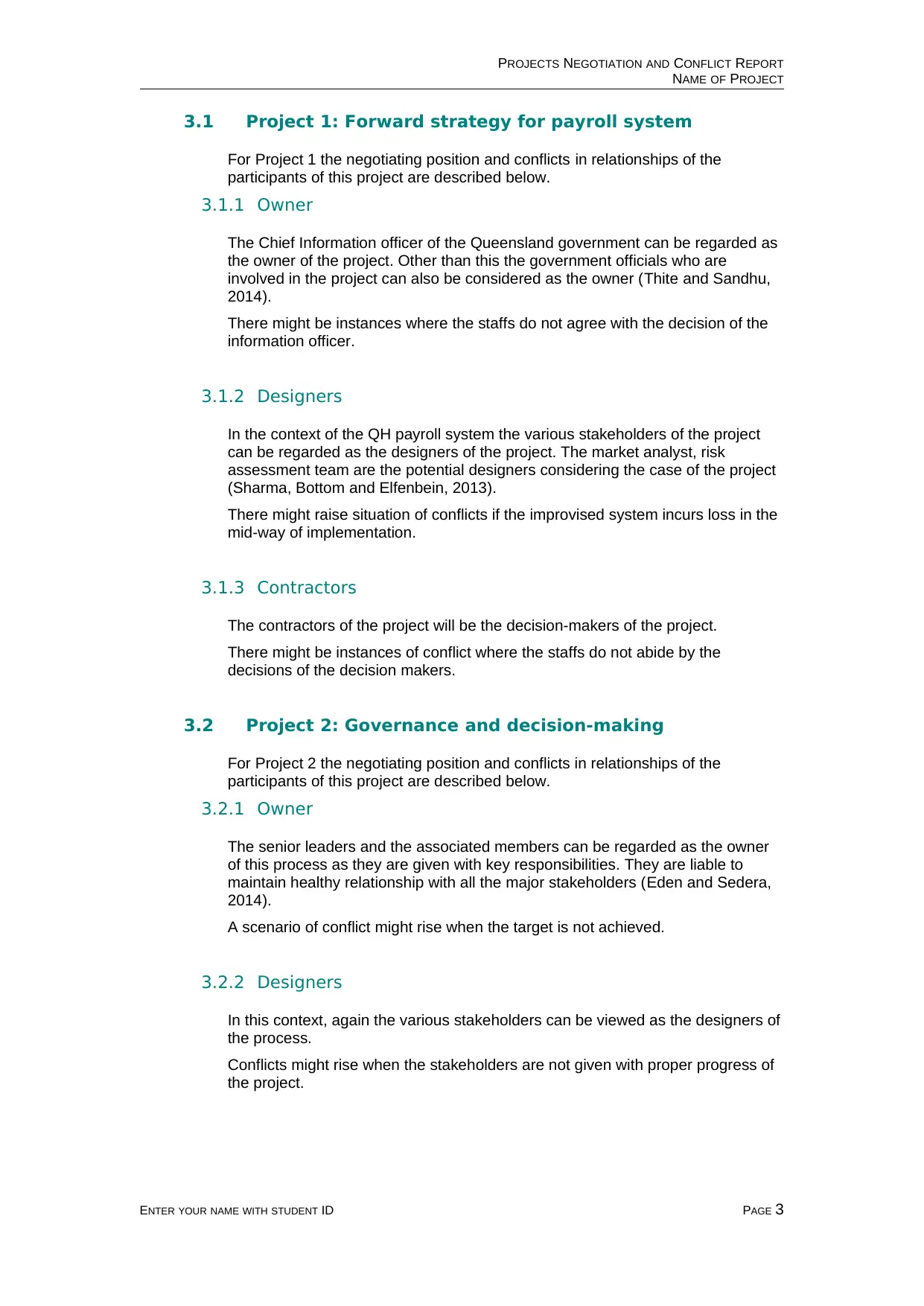
PROJECTS NEGOTIATION AND CONFLICT REPORT
NAME OF PROJECT
3.1 Project 1: Forward strategy for payroll system
For Project 1 the negotiating position and conflicts in relationships of the
participants of this project are described below.
3.1.1 Owner
The Chief Information officer of the Queensland government can be regarded as
the owner of the project. Other than this the government officials who are
involved in the project can also be considered as the owner (Thite and Sandhu,
2014).
There might be instances where the staffs do not agree with the decision of the
information officer.
3.1.2 Designers
In the context of the QH payroll system the various stakeholders of the project
can be regarded as the designers of the project. The market analyst, risk
assessment team are the potential designers considering the case of the project
(Sharma, Bottom and Elfenbein, 2013).
There might raise situation of conflicts if the improvised system incurs loss in the
mid-way of implementation.
3.1.3 Contractors
The contractors of the project will be the decision-makers of the project.
There might be instances of conflict where the staffs do not abide by the
decisions of the decision makers.
3.2 Project 2: Governance and decision-making
For Project 2 the negotiating position and conflicts in relationships of the
participants of this project are described below.
3.2.1 Owner
The senior leaders and the associated members can be regarded as the owner
of this process as they are given with key responsibilities. They are liable to
maintain healthy relationship with all the major stakeholders (Eden and Sedera,
2014).
A scenario of conflict might rise when the target is not achieved.
3.2.2 Designers
In this context, again the various stakeholders can be viewed as the designers of
the process.
Conflicts might rise when the stakeholders are not given with proper progress of
the project.
ENTER YOUR NAME WITH STUDENT ID PAGE 3
NAME OF PROJECT
3.1 Project 1: Forward strategy for payroll system
For Project 1 the negotiating position and conflicts in relationships of the
participants of this project are described below.
3.1.1 Owner
The Chief Information officer of the Queensland government can be regarded as
the owner of the project. Other than this the government officials who are
involved in the project can also be considered as the owner (Thite and Sandhu,
2014).
There might be instances where the staffs do not agree with the decision of the
information officer.
3.1.2 Designers
In the context of the QH payroll system the various stakeholders of the project
can be regarded as the designers of the project. The market analyst, risk
assessment team are the potential designers considering the case of the project
(Sharma, Bottom and Elfenbein, 2013).
There might raise situation of conflicts if the improvised system incurs loss in the
mid-way of implementation.
3.1.3 Contractors
The contractors of the project will be the decision-makers of the project.
There might be instances of conflict where the staffs do not abide by the
decisions of the decision makers.
3.2 Project 2: Governance and decision-making
For Project 2 the negotiating position and conflicts in relationships of the
participants of this project are described below.
3.2.1 Owner
The senior leaders and the associated members can be regarded as the owner
of this process as they are given with key responsibilities. They are liable to
maintain healthy relationship with all the major stakeholders (Eden and Sedera,
2014).
A scenario of conflict might rise when the target is not achieved.
3.2.2 Designers
In this context, again the various stakeholders can be viewed as the designers of
the process.
Conflicts might rise when the stakeholders are not given with proper progress of
the project.
ENTER YOUR NAME WITH STUDENT ID PAGE 3
⊘ This is a preview!⊘
Do you want full access?
Subscribe today to unlock all pages.

Trusted by 1+ million students worldwide
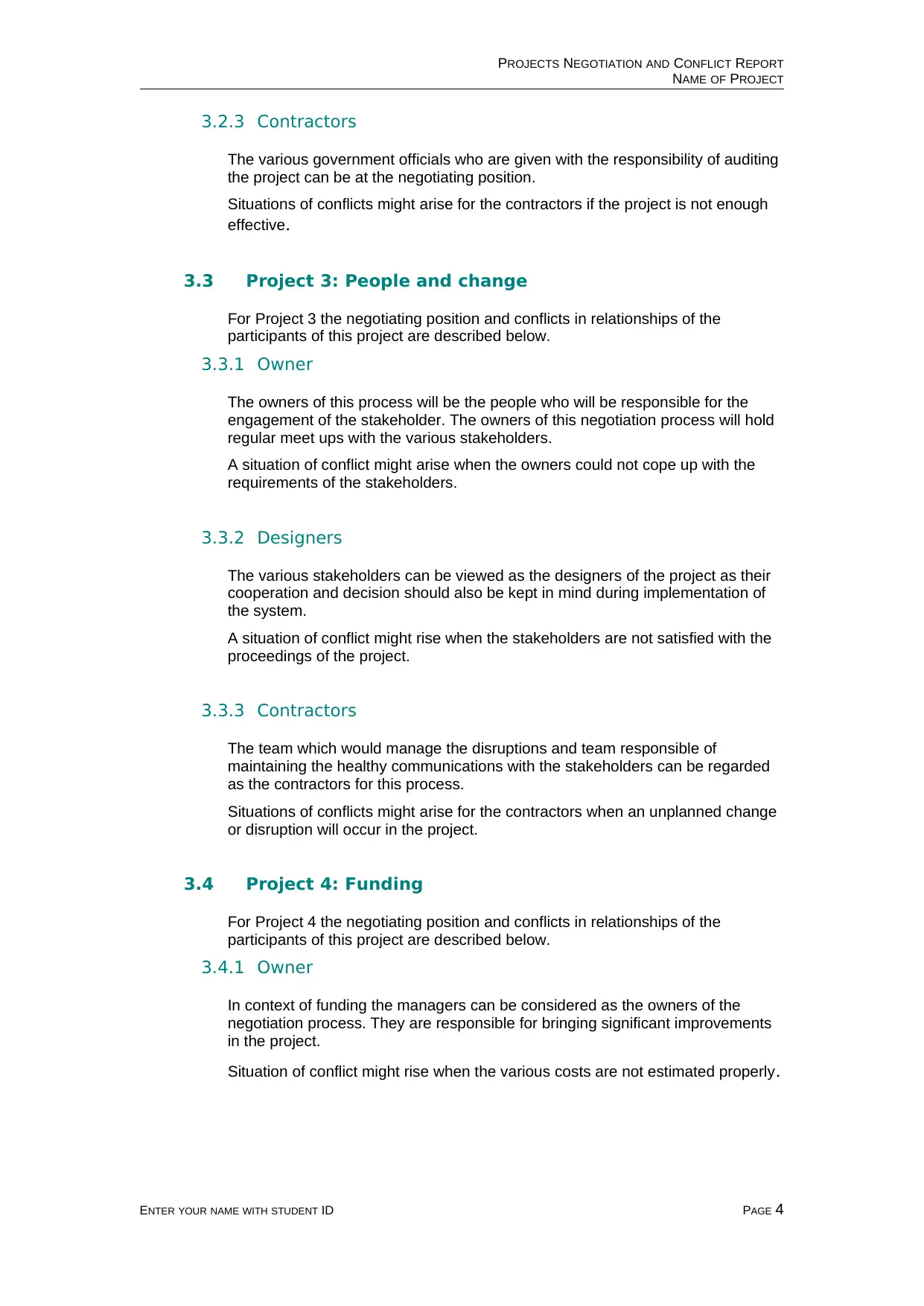
PROJECTS NEGOTIATION AND CONFLICT REPORT
NAME OF PROJECT
3.2.3 Contractors
The various government officials who are given with the responsibility of auditing
the project can be at the negotiating position.
Situations of conflicts might arise for the contractors if the project is not enough
effective.
3.3 Project 3: People and change
For Project 3 the negotiating position and conflicts in relationships of the
participants of this project are described below.
3.3.1 Owner
The owners of this process will be the people who will be responsible for the
engagement of the stakeholder. The owners of this negotiation process will hold
regular meet ups with the various stakeholders.
A situation of conflict might arise when the owners could not cope up with the
requirements of the stakeholders.
3.3.2 Designers
The various stakeholders can be viewed as the designers of the project as their
cooperation and decision should also be kept in mind during implementation of
the system.
A situation of conflict might rise when the stakeholders are not satisfied with the
proceedings of the project.
3.3.3 Contractors
The team which would manage the disruptions and team responsible of
maintaining the healthy communications with the stakeholders can be regarded
as the contractors for this process.
Situations of conflicts might arise for the contractors when an unplanned change
or disruption will occur in the project.
3.4 Project 4: Funding
For Project 4 the negotiating position and conflicts in relationships of the
participants of this project are described below.
3.4.1 Owner
In context of funding the managers can be considered as the owners of the
negotiation process. They are responsible for bringing significant improvements
in the project.
Situation of conflict might rise when the various costs are not estimated properly.
ENTER YOUR NAME WITH STUDENT ID PAGE 4
NAME OF PROJECT
3.2.3 Contractors
The various government officials who are given with the responsibility of auditing
the project can be at the negotiating position.
Situations of conflicts might arise for the contractors if the project is not enough
effective.
3.3 Project 3: People and change
For Project 3 the negotiating position and conflicts in relationships of the
participants of this project are described below.
3.3.1 Owner
The owners of this process will be the people who will be responsible for the
engagement of the stakeholder. The owners of this negotiation process will hold
regular meet ups with the various stakeholders.
A situation of conflict might arise when the owners could not cope up with the
requirements of the stakeholders.
3.3.2 Designers
The various stakeholders can be viewed as the designers of the project as their
cooperation and decision should also be kept in mind during implementation of
the system.
A situation of conflict might rise when the stakeholders are not satisfied with the
proceedings of the project.
3.3.3 Contractors
The team which would manage the disruptions and team responsible of
maintaining the healthy communications with the stakeholders can be regarded
as the contractors for this process.
Situations of conflicts might arise for the contractors when an unplanned change
or disruption will occur in the project.
3.4 Project 4: Funding
For Project 4 the negotiating position and conflicts in relationships of the
participants of this project are described below.
3.4.1 Owner
In context of funding the managers can be considered as the owners of the
negotiation process. They are responsible for bringing significant improvements
in the project.
Situation of conflict might rise when the various costs are not estimated properly.
ENTER YOUR NAME WITH STUDENT ID PAGE 4
Paraphrase This Document
Need a fresh take? Get an instant paraphrase of this document with our AI Paraphraser
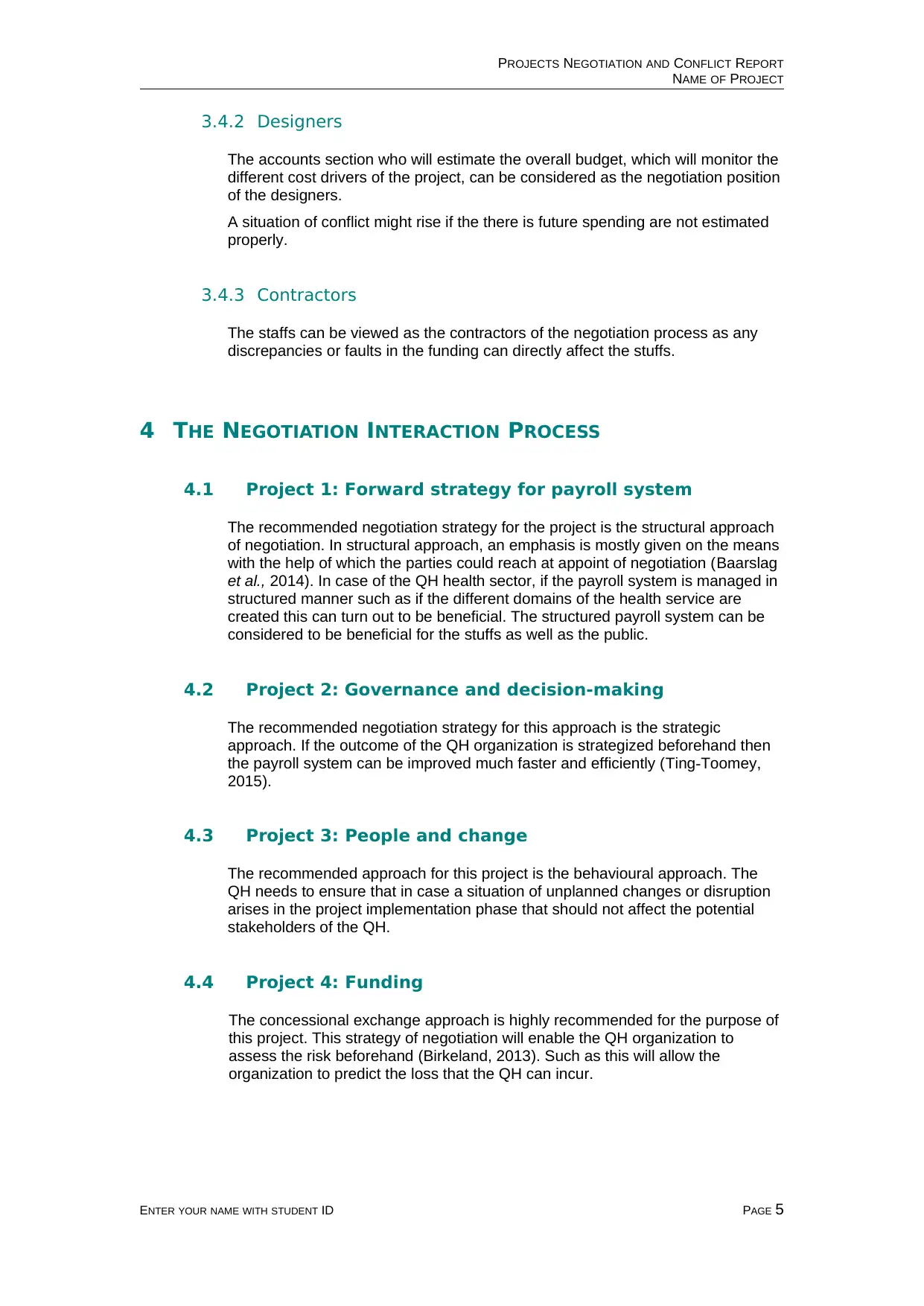
PROJECTS NEGOTIATION AND CONFLICT REPORT
NAME OF PROJECT
3.4.2 Designers
The accounts section who will estimate the overall budget, which will monitor the
different cost drivers of the project, can be considered as the negotiation position
of the designers.
A situation of conflict might rise if the there is future spending are not estimated
properly.
3.4.3 Contractors
The staffs can be viewed as the contractors of the negotiation process as any
discrepancies or faults in the funding can directly affect the stuffs.
4 THE NEGOTIATION INTERACTION PROCESS
4.1 Project 1: Forward strategy for payroll system
The recommended negotiation strategy for the project is the structural approach
of negotiation. In structural approach, an emphasis is mostly given on the means
with the help of which the parties could reach at appoint of negotiation (Baarslag
et al., 2014). In case of the QH health sector, if the payroll system is managed in
structured manner such as if the different domains of the health service are
created this can turn out to be beneficial. The structured payroll system can be
considered to be beneficial for the stuffs as well as the public.
4.2 Project 2: Governance and decision-making
The recommended negotiation strategy for this approach is the strategic
approach. If the outcome of the QH organization is strategized beforehand then
the payroll system can be improved much faster and efficiently (Ting‐Toomey,
2015).
4.3 Project 3: People and change
The recommended approach for this project is the behavioural approach. The
QH needs to ensure that in case a situation of unplanned changes or disruption
arises in the project implementation phase that should not affect the potential
stakeholders of the QH.
4.4 Project 4: Funding
The concessional exchange approach is highly recommended for the purpose of
this project. This strategy of negotiation will enable the QH organization to
assess the risk beforehand (Birkeland, 2013). Such as this will allow the
organization to predict the loss that the QH can incur.
ENTER YOUR NAME WITH STUDENT ID PAGE 5
NAME OF PROJECT
3.4.2 Designers
The accounts section who will estimate the overall budget, which will monitor the
different cost drivers of the project, can be considered as the negotiation position
of the designers.
A situation of conflict might rise if the there is future spending are not estimated
properly.
3.4.3 Contractors
The staffs can be viewed as the contractors of the negotiation process as any
discrepancies or faults in the funding can directly affect the stuffs.
4 THE NEGOTIATION INTERACTION PROCESS
4.1 Project 1: Forward strategy for payroll system
The recommended negotiation strategy for the project is the structural approach
of negotiation. In structural approach, an emphasis is mostly given on the means
with the help of which the parties could reach at appoint of negotiation (Baarslag
et al., 2014). In case of the QH health sector, if the payroll system is managed in
structured manner such as if the different domains of the health service are
created this can turn out to be beneficial. The structured payroll system can be
considered to be beneficial for the stuffs as well as the public.
4.2 Project 2: Governance and decision-making
The recommended negotiation strategy for this approach is the strategic
approach. If the outcome of the QH organization is strategized beforehand then
the payroll system can be improved much faster and efficiently (Ting‐Toomey,
2015).
4.3 Project 3: People and change
The recommended approach for this project is the behavioural approach. The
QH needs to ensure that in case a situation of unplanned changes or disruption
arises in the project implementation phase that should not affect the potential
stakeholders of the QH.
4.4 Project 4: Funding
The concessional exchange approach is highly recommended for the purpose of
this project. This strategy of negotiation will enable the QH organization to
assess the risk beforehand (Birkeland, 2013). Such as this will allow the
organization to predict the loss that the QH can incur.
ENTER YOUR NAME WITH STUDENT ID PAGE 5
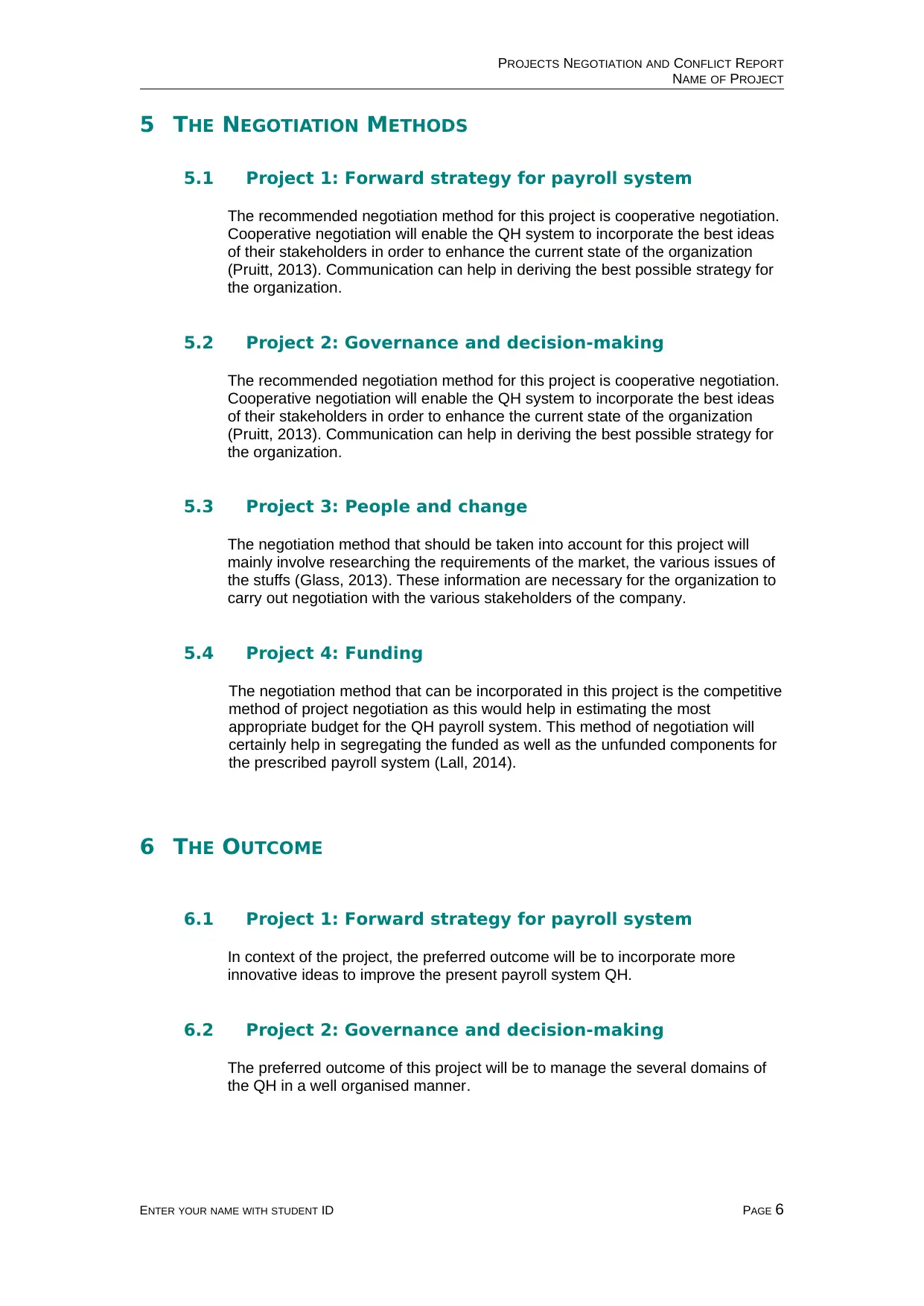
PROJECTS NEGOTIATION AND CONFLICT REPORT
NAME OF PROJECT
5 THE NEGOTIATION METHODS
5.1 Project 1: Forward strategy for payroll system
The recommended negotiation method for this project is cooperative negotiation.
Cooperative negotiation will enable the QH system to incorporate the best ideas
of their stakeholders in order to enhance the current state of the organization
(Pruitt, 2013). Communication can help in deriving the best possible strategy for
the organization.
5.2 Project 2: Governance and decision-making
The recommended negotiation method for this project is cooperative negotiation.
Cooperative negotiation will enable the QH system to incorporate the best ideas
of their stakeholders in order to enhance the current state of the organization
(Pruitt, 2013). Communication can help in deriving the best possible strategy for
the organization.
5.3 Project 3: People and change
The negotiation method that should be taken into account for this project will
mainly involve researching the requirements of the market, the various issues of
the stuffs (Glass, 2013). These information are necessary for the organization to
carry out negotiation with the various stakeholders of the company.
5.4 Project 4: Funding
The negotiation method that can be incorporated in this project is the competitive
method of project negotiation as this would help in estimating the most
appropriate budget for the QH payroll system. This method of negotiation will
certainly help in segregating the funded as well as the unfunded components for
the prescribed payroll system (Lall, 2014).
6 THE OUTCOME
6.1 Project 1: Forward strategy for payroll system
In context of the project, the preferred outcome will be to incorporate more
innovative ideas to improve the present payroll system QH.
6.2 Project 2: Governance and decision-making
The preferred outcome of this project will be to manage the several domains of
the QH in a well organised manner.
ENTER YOUR NAME WITH STUDENT ID PAGE 6
NAME OF PROJECT
5 THE NEGOTIATION METHODS
5.1 Project 1: Forward strategy for payroll system
The recommended negotiation method for this project is cooperative negotiation.
Cooperative negotiation will enable the QH system to incorporate the best ideas
of their stakeholders in order to enhance the current state of the organization
(Pruitt, 2013). Communication can help in deriving the best possible strategy for
the organization.
5.2 Project 2: Governance and decision-making
The recommended negotiation method for this project is cooperative negotiation.
Cooperative negotiation will enable the QH system to incorporate the best ideas
of their stakeholders in order to enhance the current state of the organization
(Pruitt, 2013). Communication can help in deriving the best possible strategy for
the organization.
5.3 Project 3: People and change
The negotiation method that should be taken into account for this project will
mainly involve researching the requirements of the market, the various issues of
the stuffs (Glass, 2013). These information are necessary for the organization to
carry out negotiation with the various stakeholders of the company.
5.4 Project 4: Funding
The negotiation method that can be incorporated in this project is the competitive
method of project negotiation as this would help in estimating the most
appropriate budget for the QH payroll system. This method of negotiation will
certainly help in segregating the funded as well as the unfunded components for
the prescribed payroll system (Lall, 2014).
6 THE OUTCOME
6.1 Project 1: Forward strategy for payroll system
In context of the project, the preferred outcome will be to incorporate more
innovative ideas to improve the present payroll system QH.
6.2 Project 2: Governance and decision-making
The preferred outcome of this project will be to manage the several domains of
the QH in a well organised manner.
ENTER YOUR NAME WITH STUDENT ID PAGE 6
⊘ This is a preview!⊘
Do you want full access?
Subscribe today to unlock all pages.

Trusted by 1+ million students worldwide
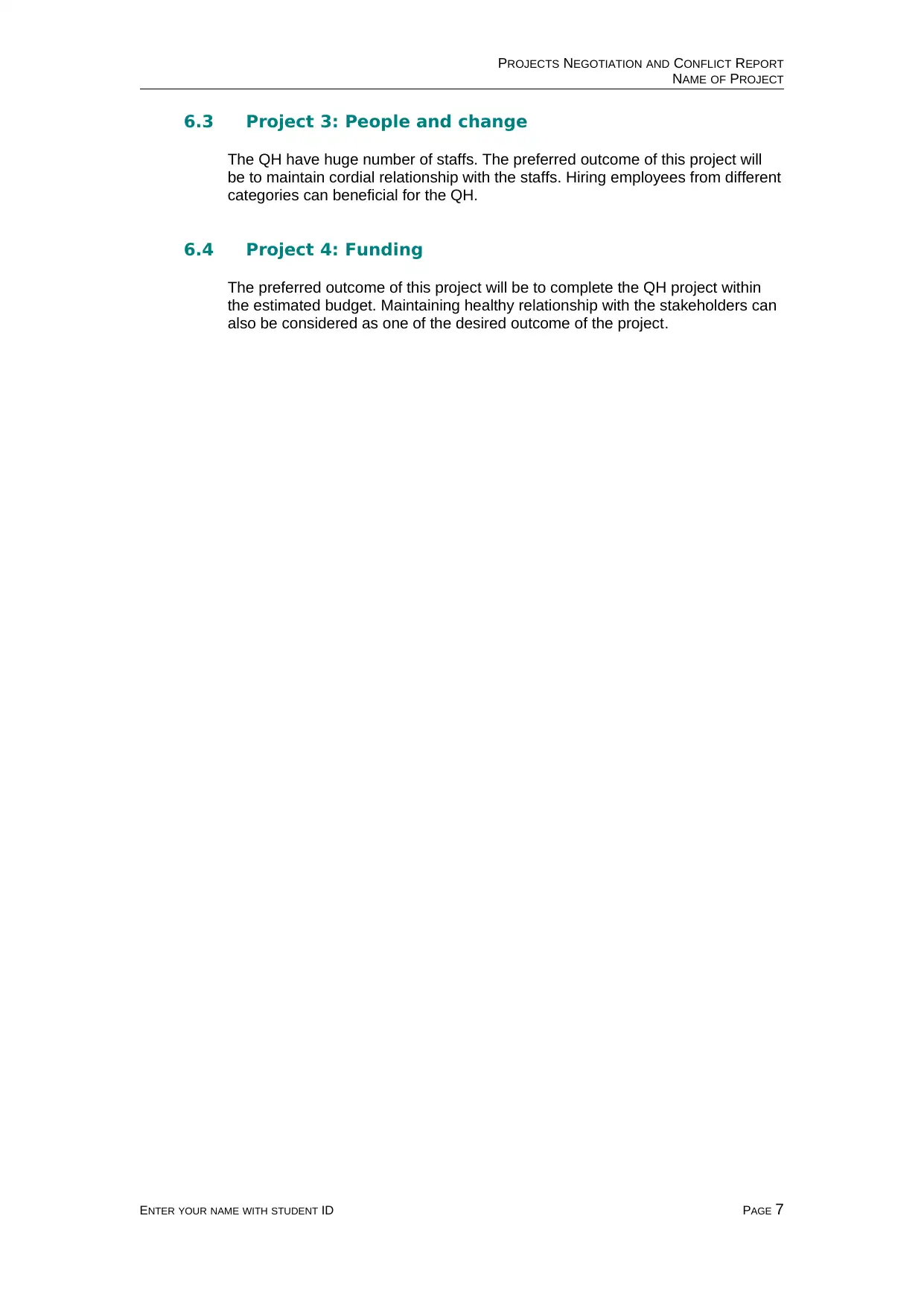
PROJECTS NEGOTIATION AND CONFLICT REPORT
NAME OF PROJECT
6.3 Project 3: People and change
The QH have huge number of staffs. The preferred outcome of this project will
be to maintain cordial relationship with the staffs. Hiring employees from different
categories can beneficial for the QH.
6.4 Project 4: Funding
The preferred outcome of this project will be to complete the QH project within
the estimated budget. Maintaining healthy relationship with the stakeholders can
also be considered as one of the desired outcome of the project.
ENTER YOUR NAME WITH STUDENT ID PAGE 7
NAME OF PROJECT
6.3 Project 3: People and change
The QH have huge number of staffs. The preferred outcome of this project will
be to maintain cordial relationship with the staffs. Hiring employees from different
categories can beneficial for the QH.
6.4 Project 4: Funding
The preferred outcome of this project will be to complete the QH project within
the estimated budget. Maintaining healthy relationship with the stakeholders can
also be considered as one of the desired outcome of the project.
ENTER YOUR NAME WITH STUDENT ID PAGE 7
Paraphrase This Document
Need a fresh take? Get an instant paraphrase of this document with our AI Paraphraser
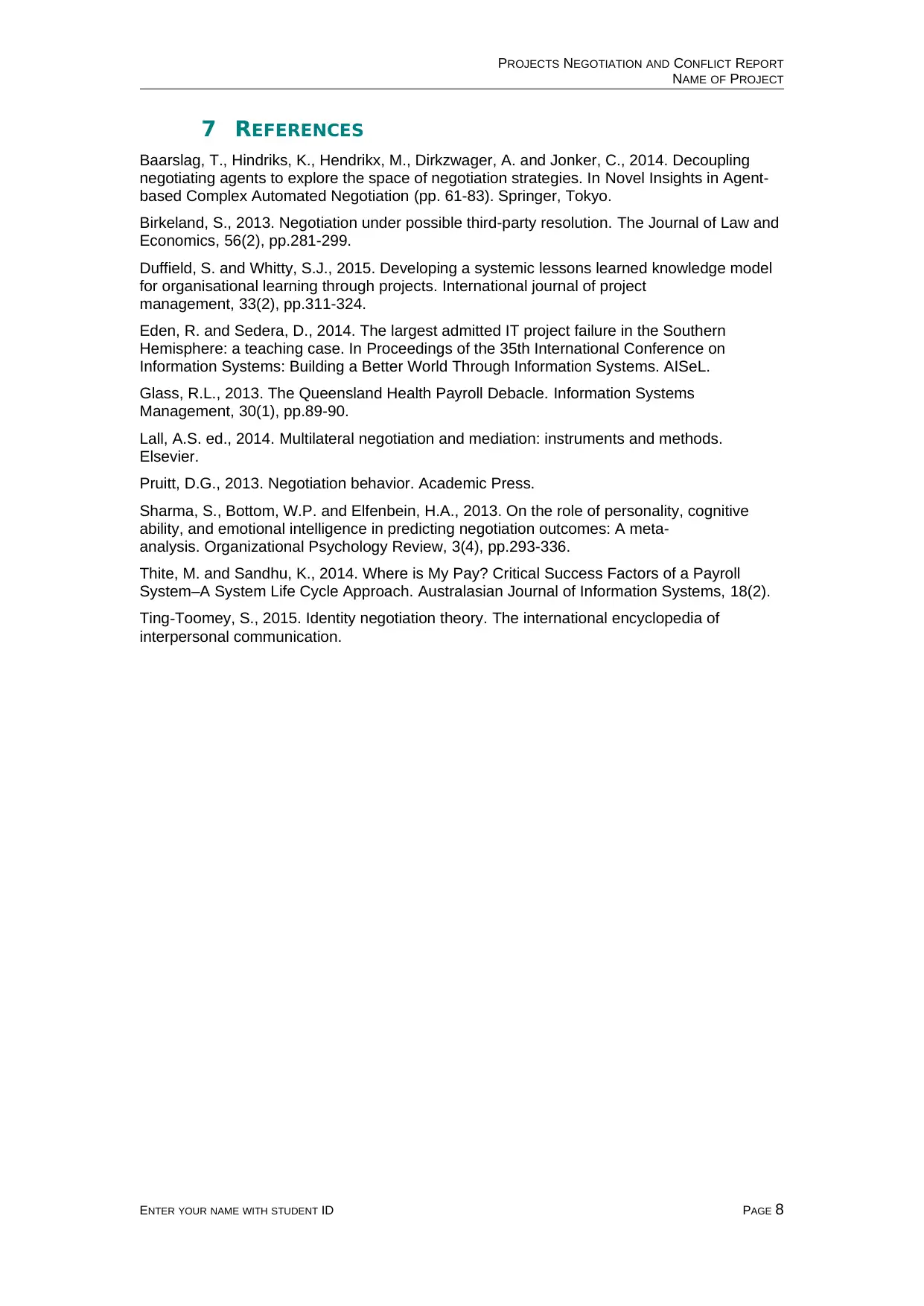
PROJECTS NEGOTIATION AND CONFLICT REPORT
NAME OF PROJECT
7 REFERENCES
Baarslag, T., Hindriks, K., Hendrikx, M., Dirkzwager, A. and Jonker, C., 2014. Decoupling
negotiating agents to explore the space of negotiation strategies. In Novel Insights in Agent-
based Complex Automated Negotiation (pp. 61-83). Springer, Tokyo.
Birkeland, S., 2013. Negotiation under possible third-party resolution. The Journal of Law and
Economics, 56(2), pp.281-299.
Duffield, S. and Whitty, S.J., 2015. Developing a systemic lessons learned knowledge model
for organisational learning through projects. International journal of project
management, 33(2), pp.311-324.
Eden, R. and Sedera, D., 2014. The largest admitted IT project failure in the Southern
Hemisphere: a teaching case. In Proceedings of the 35th International Conference on
Information Systems: Building a Better World Through Information Systems. AISeL.
Glass, R.L., 2013. The Queensland Health Payroll Debacle. Information Systems
Management, 30(1), pp.89-90.
Lall, A.S. ed., 2014. Multilateral negotiation and mediation: instruments and methods.
Elsevier.
Pruitt, D.G., 2013. Negotiation behavior. Academic Press.
Sharma, S., Bottom, W.P. and Elfenbein, H.A., 2013. On the role of personality, cognitive
ability, and emotional intelligence in predicting negotiation outcomes: A meta-
analysis. Organizational Psychology Review, 3(4), pp.293-336.
Thite, M. and Sandhu, K., 2014. Where is My Pay? Critical Success Factors of a Payroll
System–A System Life Cycle Approach. Australasian Journal of Information Systems, 18(2).
Ting‐Toomey, S., 2015. Identity negotiation theory. The international encyclopedia of
interpersonal communication.
ENTER YOUR NAME WITH STUDENT ID PAGE 8
NAME OF PROJECT
7 REFERENCES
Baarslag, T., Hindriks, K., Hendrikx, M., Dirkzwager, A. and Jonker, C., 2014. Decoupling
negotiating agents to explore the space of negotiation strategies. In Novel Insights in Agent-
based Complex Automated Negotiation (pp. 61-83). Springer, Tokyo.
Birkeland, S., 2013. Negotiation under possible third-party resolution. The Journal of Law and
Economics, 56(2), pp.281-299.
Duffield, S. and Whitty, S.J., 2015. Developing a systemic lessons learned knowledge model
for organisational learning through projects. International journal of project
management, 33(2), pp.311-324.
Eden, R. and Sedera, D., 2014. The largest admitted IT project failure in the Southern
Hemisphere: a teaching case. In Proceedings of the 35th International Conference on
Information Systems: Building a Better World Through Information Systems. AISeL.
Glass, R.L., 2013. The Queensland Health Payroll Debacle. Information Systems
Management, 30(1), pp.89-90.
Lall, A.S. ed., 2014. Multilateral negotiation and mediation: instruments and methods.
Elsevier.
Pruitt, D.G., 2013. Negotiation behavior. Academic Press.
Sharma, S., Bottom, W.P. and Elfenbein, H.A., 2013. On the role of personality, cognitive
ability, and emotional intelligence in predicting negotiation outcomes: A meta-
analysis. Organizational Psychology Review, 3(4), pp.293-336.
Thite, M. and Sandhu, K., 2014. Where is My Pay? Critical Success Factors of a Payroll
System–A System Life Cycle Approach. Australasian Journal of Information Systems, 18(2).
Ting‐Toomey, S., 2015. Identity negotiation theory. The international encyclopedia of
interpersonal communication.
ENTER YOUR NAME WITH STUDENT ID PAGE 8
1 out of 8
Related Documents
Your All-in-One AI-Powered Toolkit for Academic Success.
+13062052269
info@desklib.com
Available 24*7 on WhatsApp / Email
![[object Object]](/_next/static/media/star-bottom.7253800d.svg)
Unlock your academic potential
Copyright © 2020–2025 A2Z Services. All Rights Reserved. Developed and managed by ZUCOL.

